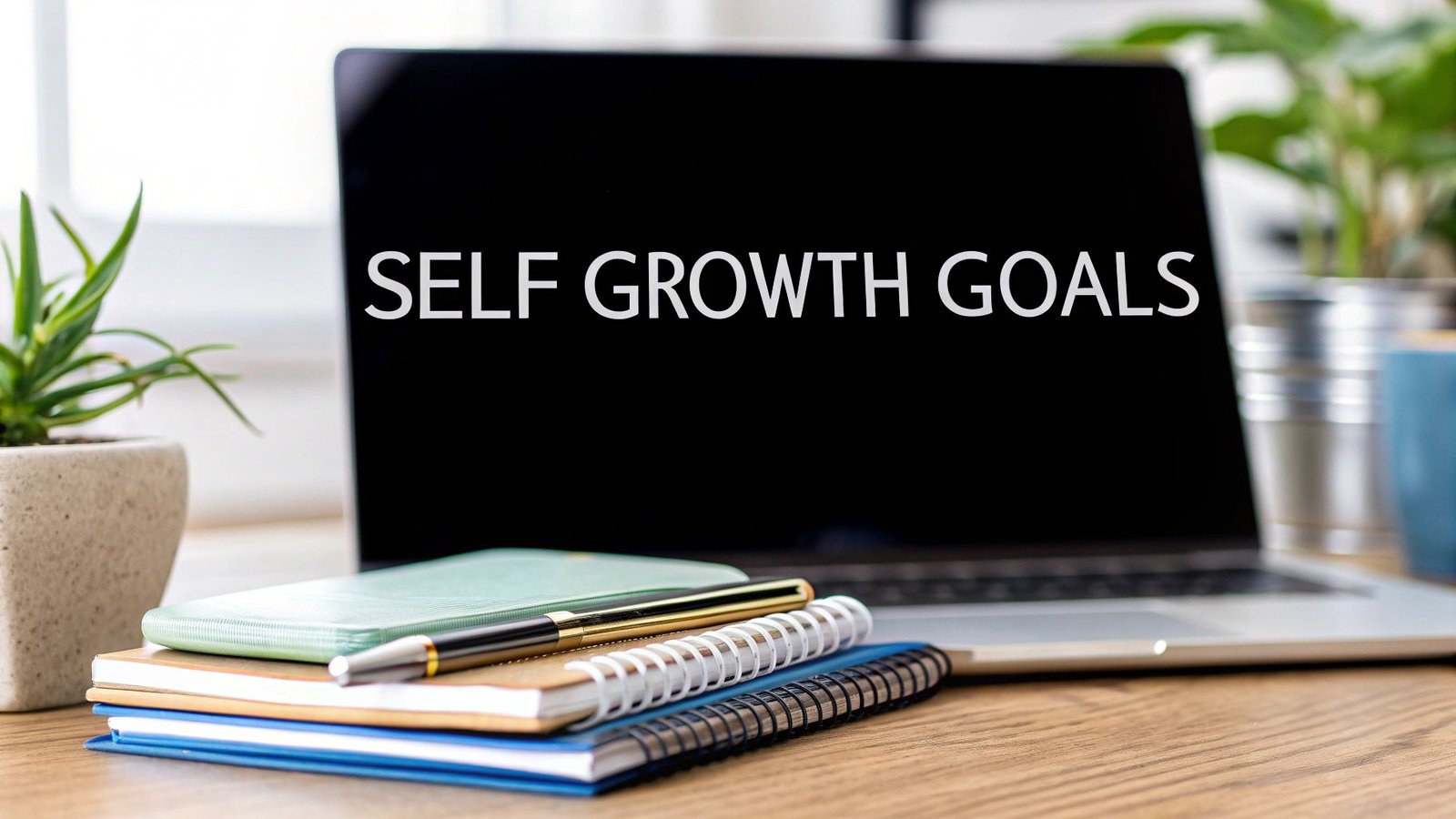Breaking Down the Psychology of Self Growth Goals

The path to personal development involves more than just writing down goals – it requires understanding the mental and emotional elements that drive real change. When we look at why some people consistently achieve their self-improvement goals while others struggle, we find that success comes down to several key psychological factors working together.
The Power of Intrinsic Motivation
At the heart of lasting change is intrinsic motivation – the natural drive that comes from within rather than external pressure or rewards. Consider learning a new language: when you're genuinely excited about connecting with different cultures and people, you're more likely to stick with it than if you're just trying to add a line to your resume. This inner drive creates the consistency needed to push through challenges and setbacks that inevitably come up along the way.
Cultivating a Growth Mindset
Your beliefs about learning and ability play a huge role in reaching self-improvement goals. People who believe they can develop their talents through effort and practice (a growth mindset) handle setbacks very differently from those who see their abilities as fixed. When you view challenges as chances to learn rather than threats to your abilities, you're more likely to keep going when things get tough. Having a growth mindset means seeing mistakes and difficulties as valuable feedback rather than failures.
The Role of Self-Efficacy
Your belief in your ability to succeed, known as self-efficacy, acts like an engine driving you toward your goals. Think about training for a marathon – if you believe deep down that you can complete it, you'll be much more likely to stick with the demanding training schedule. The same principle applies to any self-improvement goal. When you truly believe you can make positive changes, you naturally put in more effort and bounce back better from obstacles.
Implementing Actionable Strategies
While the right mindset is essential, you also need practical steps to turn goals into reality. Breaking big goals into smaller, concrete tasks helps prevent feeling overwhelmed. Simple tools like keeping a journal or using a habit-tracking app can help you see your progress and adjust your approach when needed. Research shows that people who write down their goals, make specific plans, and share their journey with others are far more likely to succeed. Small wins build momentum and confidence over time.
Creating Your Personal Growth Framework That Sticks

Now that we understand the psychology behind personal growth, let's focus on creating a practical framework that turns your goals into reality. The key difference lies in moving from vague intentions to specific actions. Think about it – saying "I want to be healthier" won't get you far, but having a detailed plan with specific meal prep days, workout schedules, and sleep routines sets you up for success. This concrete approach makes the difference between wishful thinking and actual progress.
Defining Your "Why" and Setting SMART Goals
Start by getting crystal clear on your core motivations. What's driving your desire to grow? Maybe you want to build stronger relationships, feel more confident at work, or find deeper meaning in your daily life. Understanding these deeper reasons will keep you going when things get tough. From there, turn your aspirations into SMART goals – Specific, Measurable, Achievable, Relevant, and Time-bound. Instead of saying "I'll get better at public speaking," try "I will give a 5-minute presentation to my team by March 31st." This clear target shows you exactly what to aim for and lets you track your progress along the way.
Building Habits and Routines That Support Your Goals
With clear goals in place, the next step is weaving them into your daily life through consistent habits. Just like regular exercise builds physical strength, daily practices build the mental muscle needed for lasting change. This might mean blocking off 30 minutes each morning to learn a new skill, practice meditation, or write in your journal. But willpower alone isn't enough – you need to set up your environment for success. Try turning off phone notifications during focus time or prepping healthy snacks to avoid impulse eating. Small tweaks to your surroundings can make a big difference in staying on track.
Tracking Progress and Maintaining Accountability
Keeping tabs on your progress helps maintain momentum and ensures your goals stay front and center. This doesn't mean obsessing over every detail, but rather having a simple way to measure how you're doing. If you're trying to read more, a basic reading log works great. Adding accountability also boosts your chances of success. Share your goals with a trusted friend or join a group focused on similar aims. A study from Michigan State University found that people who shared their progress with others were far more likely to achieve their goals. You might be interested in: How to master… and learn more about developing a successful plan. The social support makes a real difference in staying committed to personal growth. By combining clear goals, supportive habits, and regular check-ins, you create a solid foundation for turning your aspirations into achievements.
Modern Tools That Support Personal Growth

Personal growth requires both understanding core principles of change and making smart use of available resources. The key is finding balance – using technology thoughtfully to support your goals while staying grounded in timeless self-improvement practices. This means being selective about which tools you adopt and how you integrate them into your growth journey.
Selecting Tools That Match Your Goals
With countless apps promising to transform your life, it's easy to feel overwhelmed. The solution is to pick tools that directly support your specific growth goals and fit naturally into your daily routine. For instance, if you want to build focus, try apps like Headspace for meditation or Focus@Will for concentration-boosting music. For habit formation, apps like Habitify can help track your progress and maintain consistency.
By choosing tools with purpose, you avoid getting sidetracked by unnecessary features or endless options. Think of it like assembling a toolkit – you want the right tools for your specific projects, not every gadget available. This focused approach helps you stay on track toward your goals.
Using Technology Wisely
Digital tools work best when they support rather than replace your personal effort and reflection. Consider running as an example – a fitness tracker provides useful data about your runs, but your own dedication drives improvement. Similarly, while apps offer helpful structure and reminders, real growth comes from your internal drive and commitment to change.
Being mindful of technology also means protecting yourself from its downsides. Social media notifications and constant connectivity can easily derail your focus. Set clear boundaries around device use and schedule regular breaks from screens. This helps ensure technology remains a helpful aid rather than a source of distraction.
Creating Your Personal Growth Tech Setup
Just as businesses carefully choose their essential software, you can build a collection of digital tools that work together to support your growth. This might include apps for meditation, habit tracking, journaling, learning, and connecting with mentors. The goal is picking tools that complement each other and align with your needs.
| Tool Type | Benefit | Example |
|---|---|---|
| Mindfulness Apps | Reduced stress, improved focus | Headspace, Calm |
| Habit Trackers | Consistency, progress visualization | Streaks, Habitica |
| Journaling Apps | Self-reflection, emotional processing | Day One, Reflectly |
| Learning Platforms | Skill development, knowledge expansion | Coursera, Skillshare |
Remember that the best setup isn't about having the newest or most feature-rich apps. It's about choosing tools that fit your personal style and goals. With the personal development market expected to reach $82.33 billion by 2033, you'll have plenty of options. Focus on selecting tools that genuinely help you grow rather than chasing every new trend.
Building Your Growth Support System

While personal growth often starts as an individual journey, lasting success rarely happens in isolation. Just like athletes need coaches and teammates to reach peak performance, we all benefit from having the right people in our corner as we work on improving ourselves. Building strong relationships that provide guidance, encouragement and accountability can make the difference between giving up and breaking through to achieve our goals.
Identifying Your Support Needs
The first step is getting clear on what kind of support will help you thrive. Some people do best with regular check-ins from a trusted friend, while others need the structure of a formal group setting. For instance, if you're an introvert working on public speaking skills, you might find a small practice group with 2-3 supportive peers ideal for getting constructive feedback. An extrovert, on the other hand, may gain more energy and motivation from a larger professional networking group. Take time to reflect on your personality and goals to determine the right balance of guidance, encouragement and accountability for your needs.
Finding Mentors and Building Mastermind Groups
Having an experienced mentor in your corner can fast-track your growth by helping you learn from their journey and avoid common pitfalls. Look for people who embody the qualities you want to develop and seem genuinely interested in helping others succeed. You can find potential mentors through professional networks, online communities, or even your existing connections. Another powerful option is joining or creating a mastermind group – a small collective of peers working toward similar goals who meet regularly to share insights, solve problems, and hold each other accountable. The varied perspectives and mutual support in these groups often leads to breakthroughs that would be difficult to achieve alone.
Cultivating Relationships That Foster Growth
Beyond formal mentoring relationships, the people you spend time with day-to-day have a huge impact on your growth. Surround yourself with friends and family who believe in your potential and encourage you to push past your comfort zone. Share your goals with loved ones so they understand what you're working toward and can cheer you on. At the same time, maintain healthy boundaries and avoid becoming overly dependent on others' approval. True growth comes from within, so while external support is valuable, you need to stay connected to your own inner motivation.
Overcoming Relationship Challenges in Personal Development
Even the strongest support systems face occasional bumps in the road. Differing opinions, competing priorities, and natural evolution in relationships can create tension. The key is addressing challenges directly through open, honest communication while setting clear expectations upfront. When conflicts arise, view them as opportunities to strengthen bonds by working through differences constructively. Remember that as you grow and change, your support needs may shift too. Stay flexible and willing to adjust your circle over time. Check out our guide on How to master… for more tips on building an effective personal development plan. With the right support system in place, your growth journey becomes less of a solo trek and more of a shared adventure – dramatically increasing your odds of creating lasting positive change.
Measuring Progress Without Losing Motivation
Progress tracking for personal growth doesn't have to feel like a chore. When done right, measuring your journey can actually fuel your motivation and highlight meaningful changes that might otherwise go unnoticed. The key is finding a balanced approach that captures both concrete achievements and subtle inner shifts.
Quantifying Your Achievements: Tracking the Tangible
Numbers give us clear feedback on our progress. By breaking down big goals into specific, measurable actions, we create a roadmap for growth. For example, if you want to become a better public speaker, you might track how many presentations you give each month or the size of audiences you address. Like checking your position on a road trip, these concrete markers show how far you've come and help maintain forward momentum. The key is choosing metrics that truly matter for your specific goals rather than tracking everything possible.
Qualitative Growth: Measuring the Intangible
Some of the most important changes can't be captured in numbers alone. Think about developing patience – while you can't measure it directly, you might notice yourself responding more calmly to stressful situations or taking time to think before reacting. These subtle shifts in mindset and behavior are equally valuable indicators of growth. Pay attention to how you feel, think, and respond differently as you progress. These qualitative observations often reveal the deeper impact of your efforts.
Tools and Techniques for Tracking Progress
Finding the right mix of tracking tools makes a big difference. For numbers-based goals, simple solutions like Google Sheets or habit-tracking apps work well. Qualitative changes benefit from regular journaling or voice notes where you can reflect on your experiences and notice patterns over time. The best approach combines both – maybe tracking meditation minutes while also noting how your stress response changes. This gives you a complete picture of your development.
Celebrating Milestones and Maintaining Momentum
Small wins deserve recognition. Taking time to acknowledge progress, whether it's treating yourself to something special or sharing achievements with friends, reinforces positive changes and builds momentum. Think of personal growth like training for a marathon – steady progress matters more than occasional sprints. Recent market research shows personal development is becoming increasingly important, with the industry expected to reach $82.33 billion by 2033. This reflects how many people are actively working on self-improvement. By tracking both measurable achievements and inner growth while celebrating progress along the way, you create an encouraging environment for lasting change. Remember, the goal isn't perfection – it's consistent growth over time.
Overcoming Growth Plateaus and Setbacks
Everyone faces obstacles on their path to personal growth. Like climbing a mountain, progress rarely follows a straight line upward – there are periods of steady gains, flat stretches where you feel stuck, and occasional slides backward. Understanding how to work through these natural challenges is key to achieving lasting growth.
Identifying and Addressing Different Types of Plateaus
Growth plateaus show up in several common forms. Sometimes it's a performance plateau, where you stop seeing improvement despite putting in consistent effort – like running the same pace day after day without getting faster. Other times, it's a motivation plateau, when your initial excitement fades and you lose your drive. Or you might hit a learning plateau, feeling unable to grasp new concepts needed to advance further.
Each type of plateau needs its own solution. For performance plateaus, try changing up your approach – work with an expert to refine your technique, adjust your training intensity, or identify weak spots. A weightlifter stuck at the same numbers might benefit from having a trainer review their form or suggest new exercises. When motivation drops, reconnect with your core reasons for pursuing growth in the first place. Remind yourself why this matters to you personally. Learn more about staying motivated in our guide about How to master…. For learning plateaus, break complex topics into smaller pieces, experiment with different learning styles, or find a mentor who can share their experience.
Turning Setbacks Into Stepping Stones
Unlike plateaus, setbacks are unexpected disruptions that can knock you off course – things like illness, job loss, or relationship problems that derail your progress and shake your confidence. But setbacks don't have to be permanent roadblocks. Successful people often view them as valuable feedback and opportunities to learn. They analyze what went wrong, identify areas to improve, and adjust their approach accordingly. For instance, someone whose business venture fails can study their mistakes, better understand market dynamics, and launch a stronger company next time.
Maintaining Momentum When Motivation Wanes
Staying motivated for the long haul takes more than willpower alone. You need a growth mindset that sees challenges as learning opportunities rather than threats. This outlook helps you bounce back from difficulties and maintain optimism. It's also important to celebrate small wins along the way – even minor progress deserves recognition since it reinforces positive habits. Having supportive people around you makes a big difference too. Share your goals with friends and family who encourage you, or join communities of others working toward similar aims. They can provide accountability and support during tough times. Studies show that 46% of people achieve their New Year's resolutions when they have the right mindset and support system. And with personal development becoming an $82.33 billion industry by 2033, there are more resources than ever to help you succeed.
Ready to take control of your career and unlock your full potential? CareerTruth provides the guidance and resources you need to navigate the complexities of the modern career landscape and achieve lasting success. Visit CareerTruth today and start your journey toward a more fulfilling and purposeful career.


